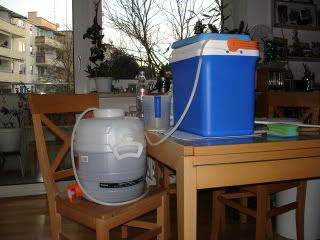Messed up my Weizenbock
So it will end up being a Dunkelweizen. Funny how these things turn out. I am sure it will end up being quite a tasty Dunkelweizen, because it smelled sehr gut.
The only reason it is not a bock, is because a missed my OG by a few points. I was aiming toward the much lighter side of a bock, but since I missed it (first time I have done wheat, and the percentage was 60%+ of the total grain), it is into weissbier territory. This being said, the IBUs will be a little higher as well, I am sure.
Here is the recipe... I think it will turn out great! Note that it was a small batch, with the final volume being near 10L.
Dunkelweizen in Munich
15-B Dunkelweizen

Size: 10.22 L
Efficiency: 70.18%
Attenuation: 80.5%
Calories: 178.11 per 12.0 fl oz
Original Gravity: 1.054 (1.044 - 1.056)
=====================#==========
Terminal Gravity: 1.011 (1.010 - 1.014)
==========#=====================
Color: 15.3 (13.0 - 14.0)
================================
Alcohol: 5.7% (4.3% - 5.6%)
=========================#======
Bitterness: 23.85 (10.0 - 18.0)
================================
Ingredients:
3.6 lbs Wheat Malt
1.3 lbs Pilsner Malt
0.5 lbs Munich TYPE I
0.33 lbs Caramunich® TYPE II
0.09 lbs Chocolate Malt
0.02 lbs Roasted Barley
0.38 oz Hallertau Tradition (8%) - added during boil, boiled 60 min
0.11 oz Hallertau Tradition (8.0%) - added during boil, boiled 15 min
1.0 ea White Labs WLP300 Hefewizen Ale
Schedule:
00:03:00 Mash In - Liquor: 4.14 L; Strike: 134.2 °F; Target: 122 °F
00:23:00 Protein Rest - Rest: 20 min; Final: 118.8 °F
00:24:00 Infusion - Water: 4.0 L; Temperature: 211.8 °F; Target: 157 °F
01:24:00 Sac Rest - Rest: 60 min; Final: 147.8 °F
01:25:00 Infusion - Water: 2.61 L; Temperature: 212 °F; Target: 160.9 °F
01:55:00 Sparge - FirstRunnings: 0.0 L sparge @ 168.0 °F, 7.0 L collected, 15 min; Second: 7.0 L sparge @ 170 °F, 7 L collected, 15 min; Total Runoff: 14.0 L
Notes:
Put some comments here:
Results generated by BeerTools Pro 1.0.22



